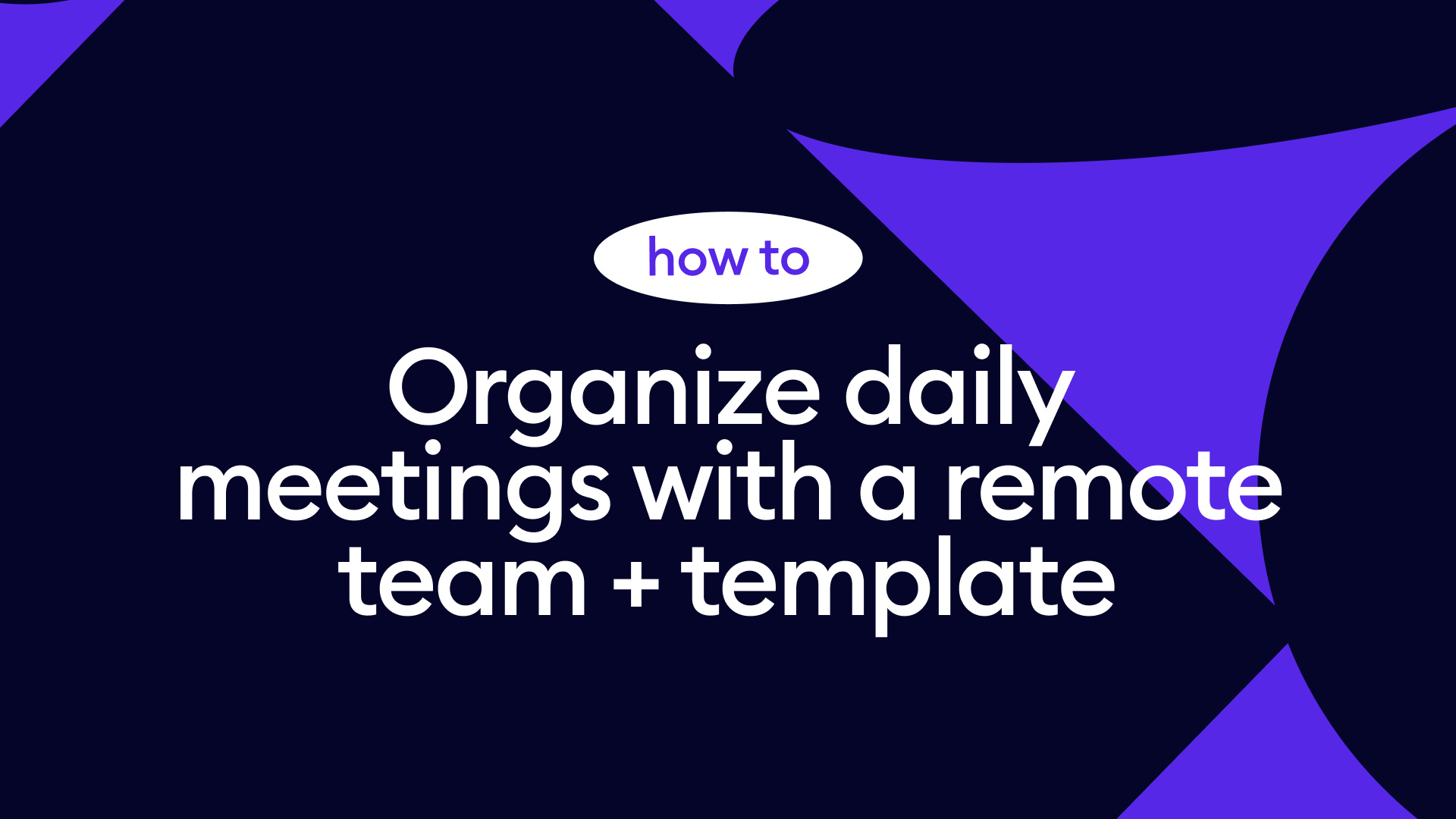How to organize daily meetings with a remote team + template
Meanwhile, many employees complain that their such meetings are boring and pointless. Let's dive into what's wrong with online daily stand-ups and how to fix it to get benefits from them.

Nowadays a daily standup meeting is a common practice most of teams where they synchronize their work and plan for the day ahead. For remote teams specifically, this is a great way to coordinate work, share progress, identify risks, and stay connected.
Meanwhile, many employees complain that their such meetings are boring and pointless. Let's dive into what's wrong with online daily stand-ups and how to fix it to get benefits from them.
Do we still need daily stand-ups?
Daily stand-ups are typically short, lasting no more than 15 minutes, and are held in the morning. Originally they were developed for agile software development as daily scrum meeting, where they were seen as a way to keep everyone on the same page and to resolve blockers quickly. However, today they are used in other contexts, such as product development, marketing, and customer service.
There are a number of benefits to daily standups, including keeping everyone on the same page, resolving blockers, and encouraging communication. These meetings help to ensure that everyone on the team is aware of the progress that is being made and of any blockers that need to be addressed. Team members identify blockers early on and resolve them quickly which helps to prevent delays and to keep the project on track. Also, remote team members get the opportunity to collaborate and build trust.
However, for some reasons it can be challenging sometimes to host to a daily stand up meeting. They can be time-consuming: if daily standups are not well-run, they can be a waste of time. Also, if the same information is shared every day, the meeting agenda becomes repetitive and boring. Finally, once such a daily meeting is held at a time when people are trying to focus on their work, it may become disruptive.
Ultimately, whether or not a daily standup is still necessary depends on your team's specific needs and circumstances. If you find that they are not being productive or helpful, you may want to consider a different approach.
The challenges of hosting remote stand-ups
As mentioned, on the one hand, during a daily stand up meeting team members report on what they did yesterday, what they plan to do today, and any blockers they are facing. While on the other, it could be a tedious unproductive experience, especially if the meeting is not well-run.
Here are some obstacles to hold productive stand-ups remotely:
- Scheduling a meeting time that works for everyone. This can be difficult, especially if the team is spread across multiple time zones. If the meeting is too early or too late for some team members, they may not be able to attend, which can disrupt the flow of the meeting.
- Participation from everyone. If some team members are unable to attend the meeting, it can be difficult to get everyone's input. This can lead to missed opportunities to collaborate and solve problems.
- Daily stand-ups can be unpopular because they can be disruptive to the flow of work. If a team member is in the middle of a task, they may have to stop what they are doing to attend it. This can be frustrating and disrupt their productivity.
- Lack of engagement and sometimes too much focus on the past may decrease engagement. When team members are asked to report on what they did yesterday, they may be tempted to focus on the problems they encountered, rather than the progress they made. This can create a negative atmosphere and can discourage team members from taking risks.
Finally, daily standup meeting can be simply ineffective. If the meeting is not well-run, it can be difficult to get everyone's attention and to keep the discussion on track. This can lead to wasted time, over/under communication, or frustration.
How to make remote standups work out
Meeting frequency for the team matters
There are some factors that may affect the meeting frequency for your team's daily standups. These include:
- The size of the team: If your team is small, you may be able to get away with holding standups less frequently, such as every other day. However, if your team is large, it's important to hold standups daily so that everyone has a chance to participate.
- The complexity of the work: If the work your team is doing is complex, you may need to hold standups more frequently to ensure that everyone is on the same page.
- Time zone differences: If your team is distributed across multiple time zones, you may need to adjust the meeting frequency to accommodate everyone's schedule.
Here are some additional tips for choosing the meeting frequency for your team's daily stand-ups:
- Consider the team's workload. If the team is working on a particularly demanding project, you may need to hold standups more frequently to ensure that everyone is on track.
- Be flexible. The meeting frequency may need to be adjusted depending on the team's needs. For example, if the team is facing a particularly difficult challenge, you may need to hold standups more frequently to stay on track.
- Communicate with the team. It's important to communicate with the team about the meeting frequency and why it's important. This will help to ensure that everyone is on board and that the stand-ups are productive.
By following these tips, you can choose the meeting frequency that's right for your team and ensure that your daily stand-ups are effective and engaging.
Great agenda, timing, and formats for effective meetings
Here are some ideas for switching up the meeting agenda of your daily standup:
- Ask different questions. The traditional daily standup questions are "What did you do yesterday?", "What will you do today?", and "Are there any blockers?". You can switch things up by asking different questions, such as "What's your biggest challenge today?", "What's one thing you're excited about working on?", or "What's one thing you learned yesterday?".
- Use a different format. Instead of the traditional round-robin format, you could try using a different format, such as a whiteboard, a shared document, or a tool like Standuply.
- Change the timing. If your team is finding that the daily standups are too long, you could try shortening them or changing the timing. For example, you could have a morning standup and an afternoon standup.
- Add a new activity. You could add a new activity to your daily standup, such as a team check-in, a brainstorming session, or a retrospective.
◉ Team check-in: How are you feeling today? Are there any personal or professional challenges you're facing?
◉ Brainstorming: What are some ideas for improving our team's process?
◉ Retrospective: What went well yesterday? What could we improve?
◉ Blockers: Are there any blockers that are preventing you from making progress?
How to use the power of technology
There are many video conferencing platforms for daily standups, and the best one for you will depend on your team's needs and preferences. Here are some factors to consider when choosing a video platform for daily standups, such as cost, features, security, ease of us, and others.
- Some video platforms are free to use, while others have a subscription fee. It's nice to factor in the cost of the platform when making a decision.
- It’s great to compare features, for example, some platforms allow you to share your screen, while others do not.
- Security. If you're working on sensitive projects, it's important to choose a video platform that has strong security features.
- The video platform should be easy to use for everyone on your team.
- Compatibility. Make sure that the video platform is compatible with the devices that your team members use.
Once these factors are considered, start narrowing down your options. If are going to try SpatialChat for these purposes, we’d love to share some best practices:
- Build customizable huddle meeting rooms for your daily breakout.
- Embed the content you like to make sure the stand-ups are productive: add Whiteboards, iFrame or Google Docs for your convenience.
- Use the chat function to communicate with team members who are not able to talk during the standup and prefer text meetings. This will help to ensure that everyone is on the same page.
- Make discussion notes: use different colors, resize, drag and drop them at any place on the background to fix your ideas during discussions.
- Record the standups. This will allow team members who missed the standup to catch up.

Meeting leader role to eliminate unrelated discussions
It is crucial to have a definite meeting leader for daily stand-ups. The meeting leader is responsible for keeping the standup on track, ensuring that everyone has a chance to participate, and resolving any conflicts that may arise. This person also documents the standup and shares the notes with the team.
Meeting Leader: Hi, everyone! Welcome to today's standup.
Employee 1: Hi.
Employee 2: Good morning.
Meeting Leader: Let's start by sharing what you did yesterday, working on today, and if you have any blockers.
Employee 1: Yesterday, I finished implementing the new user interface for the website. Today, I'm going to be testing it and making sure that it's working properly. I don't have any blockers at the moment.
Meeting Leader: Great, thanks for sharing.
Employee 2: Yesterday, I was working on the new feature for the app. I'm still working on it, but I'm hoping to have it finished by the end of the day. I don't have any blockers at the moment.
Meeting Leader: Good to hear.
Meeting Leader: Is there anyone else who has anything to share?
Employee 3: I have a blocker. I'm trying to integrate the new API, but I'm having trouble getting it to work.
Meeting Leader: Okay, let's take a look at that.
The meeting leader and Employee 3 discuss the blocker. The meeting leader helps Employee 3 to identify the problem and to come up with a solution.
Meeting Leader: Okay, I think I see what the problem is. Let me try to fix it.
The meeting leader fixes the blocker and sends a meeting meme to celebrate this small victory.
Meeting Leader: Okay, I think I fixed it. Let's try it again.
Employee 3 tries the API again and it works.
Employee 3: Thanks, that worked!
Meeting Leader: You're welcome.
Meeting Leader: Okay, that's all for today's standup. Thanks everyone for your participation.
Employees: Thanks!
This is just an example, and the specific dialogue will vary depending on the team and the specific blockers that are encountered. However, this should give you a good starting point for creating your own dialogue for your daily stand-ups.
By sharing the follow-up of your daily stand-ups, a meeting leader helps to keep everyone on the same page and to ensure that the team is making progress.
Helpful materials
Here are some helpful links and great resources to dive deeper into the world of SpatialChat.
Let's explore it😊

Basics of SpatialChat
Let's kick things off with some simple guidelines to help you begin your journey of interacting.

Use cases Guides
Discover creative ways to enhance your virtual interactions and collaborations..
